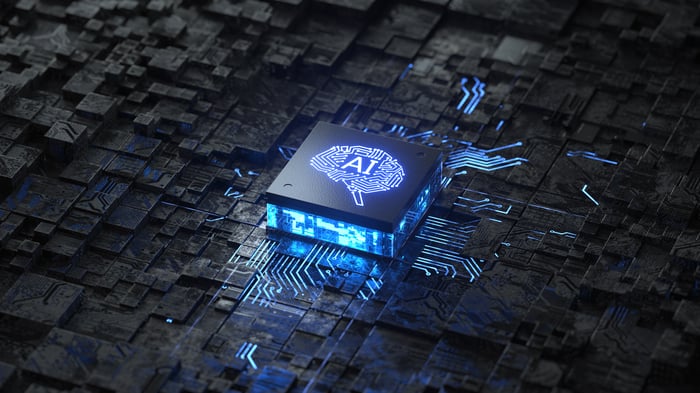The semiconductor industry is the beating heart of the artificial intelligence (AI) revolution. It produces the advanced chips for data centers where developers build, train, and deploy their AI models. Nvidia's (NVDA 6.18%) graphics processing units (GPUs) are best-in-class for those applications.
Nvidia stock has more than tripled over the last 12 months, carrying the company to a $2.2 trillion valuation. Only Apple and Microsoft are worth more.
Nvidia will likely continue to create value for investors, so I'm being facetious when I tell you to forget about the company. But the AI industry is evolving quickly and a number of other stocks in the chip space are also surging. Micron Technology (MU 2.92%) stock just hit a record high of $113.50, surpassing its previous best-ever level from two years ago. Here's why it's not too late to buy.
The data center isn't the only game in town when it comes to AI
Micron is one of the world's leading producers of memory (DRAM) and storage (NAND) chips, both of which are increasingly important to extracting maximum performance from Nvidia's data center GPUs. In fact, Nvidia chose Micron's HBM3E memory solution to power its latest H200 chip, which is the successor to its industry-leading H100.
Micron's HBM3E memory consumes an estimated 30% less energy than competing hardware, and reducing electricity usage is a growing focus for data center operators due to the sheer amount of computing power commanded by AI workloads. Therefore, it's no surprise that Micron's high-bandwidth memory (HBM) is completely sold out for calendar 2024, and most of its calendar 2025 supply has also been allocated already.
But Micron's AI opportunity is now expanding beyond the data center. Every new computer and mobile device will soon be fitted with AI processors, which will speed up response times and improve the user experience. The chipsets inside next-generation computers are called neural processing units (NPUs) and are specifically designed to handle AI workloads. They require up to 80% more DRAM content than today's average PC chips, and that translates to more revenue for Micron.
In the mobile space, Micron expects AI-enabled smartphones to carry up to double the DRAM content compared to traditional models. Micron's AI chips can be found in Samsung's new Galaxy S24 device, which comes with a host of AI features. One of them is Live Translate, which allows two people to speak over the phone in different languages, and another is Circle to Search, which recognizes objects in photos and allows the user to instantly run an online search.
On-device processing is the industry's next frontier, because it will take AI out of the data center and insert it into everyday life. Demand is already soaring; Advanced Micro Devices is a leader in AI CPU and NPU technologies, and it has shipped millions of AI-enabled computers to date.
Micron has returned to profitability
Micron's revenue plunged by 50% during fiscal 2023 (ended Aug. 31, 2023), dragging the company's bottom line to a net loss of $5.8 billion for the year. Pandemic-related supply shortages caused the chip industry to overproduce, leading to an inventory glut and plummeting prices.
Micron has now emerged from that period. The company's revenue returned to growth in the fiscal 2024 first quarter (ended Nov. 30, 2023), although it still lost more than $1.2 billion at the bottom line. But the recent fiscal 2024 second quarter (ended Feb. 29, 2024) was a true breakout period for the company.
Micron delivered $5.8 billion in revenue, which was a whopping 57% year-over-year increase, and it also crushed the company's forecast of $5.3 billion. Plus, it generated a net income of $793 million, which marked a welcome return to profitability.
CEO Sanjay Mehrotra attributed the strong quarter to a tightening supply demand balance, which had a positive impact on prices across all end markets. However, he also gave a nod to the strength in AI server (data center) demand.
Micron is forecasting $6.6 billion in revenue for the upcoming fiscal 2024 third quarter (ending June 1), which would represent an increase of 76% compared to the year-ago period. That would be a powerful growth acceleration from the second quarter.

Image source: Getty Images.
Why Micron stock is a buy despite trading at an all-time high
Since Micron was losing money up until Q2, investors can't use the price-to-earnings (P/E) ratio to value its stock. However, based on the company's trailing-12-month revenue of $18.3 billion and its current market capitalization of $122 billion, Micron stock trades at a price-to-sales (P/S) ratio of 6.7.
That's extremely cheap compared to Nvidia stock, which trades at a P/S ratio of 37, and even Advanced Micro Devices stock, which trades at a P/S ratio of 12.9. Those names deserve a premium because their work in the GPU, CPU, and NPU spaces is unprecedented, and they effectively create demand for Micron's products.
However, AI is expected to add anywhere between $7 trillion and $200 trillion to the global economy over the next 10 years, and Micron's hardware is a key component to unlocking that value creation. The company is ramping up the pace of innovation; it's now sampling its 12-high HBM3E data center product, which increases DRAM capacity by 50%. That means companies like Nvidia can pack more memory into each GPU, which leads to faster training and inferencing, paving the way for more advanced AI models.
With Micron's revenue growth clearly accelerating, the all-time high in its stock shouldn't deter investors from buying it -- especially considering its valuation and the substantial opportunity that lies ahead.





